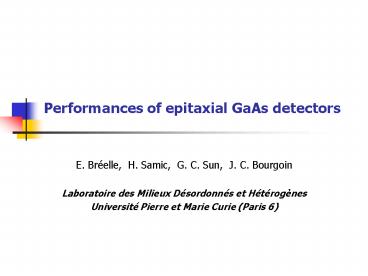Performances of epitaxial GaAs detectors PowerPoint PPT Presentation
Title: Performances of epitaxial GaAs detectors
1
Performances of epitaxial GaAs detectors
- E. Bréelle, H. Samic, G. C. Sun, J. C.
Bourgoin - Laboratoire des Milieux Désordonnés et
Hétérogènes - Université Pierre et Marie Curie (Paris 6)
2
Introduction
- Material for X-ray imaging
- Bulk
Epitaxial - Semi-insulating
Thick enough - Large defect concentration,
Low defect concentration, - ?Non-uniform electronic
properties Residual doping (1013-1014
cm-3) - ?Short life time
?Small depleted depth - Imaging at room temperature
- Bulk CdTe
Epitaxial GaAs (InP,
GaP..) - Limited area
Large area - Bad homogeneity
Homogenous - No technology
Existing technology -
? Limitation in space
charge region
3
Aim of the work
Epitaxial GaAs detector
4
What has been achieved by Chemical Reaction
method
A. Growth of thick epitaxial GaAs layers
100-500 µm thick layers Homogenous
electronic properties Electronic properties
similar to that of standard epilayers
B. Pixel technology Polishing Ion
implantation annealing Photolithography
Chemical etching Si3N4 deposition
Metallic alloy deposition
5
What has been achieved by Chemical Reaction
method
C. Photo current induced by X-ray
6
Results
- 1. Proton detection
- GaAs detector 2 mm2, 4.3 x 1014 cm-3, bias of
100 V (depleted depth 18.4 µm) - Retrodiffusion of 1.2 MeV (a) and 1.3 MeV (b)
protons
7
Results
- 2. Electron detection
- Si detector 25 mm2, depleted depth 100 µm at 50
V - GaAs detector 2 mm2, depleted depth about 13 µm
at 50 V.
8
Results
- 3. Alpha detection (241Am)-5.49 MeV
- Bias of 80 V
9
Results
- 4. Gamma detection (241Am)- 59 keV
- Cooled at 50C, at bias of 70V
10
Conclusion
- Good energy resolution
- Width of the space charge region, small !
- Decrease of the residual doping
- Work in photocurrent
- 3. Optimise the technology of the detector.
PowerShow.com is a leading presentation sharing website. It has millions of presentations already uploaded and available with 1,000s more being uploaded by its users every day. Whatever your area of interest, here you’ll be able to find and view presentations you’ll love and possibly download. And, best of all, it is completely free and easy to use.
You might even have a presentation you’d like to share with others. If so, just upload it to PowerShow.com. We’ll convert it to an HTML5 slideshow that includes all the media types you’ve already added: audio, video, music, pictures, animations and transition effects. Then you can share it with your target audience as well as PowerShow.com’s millions of monthly visitors. And, again, it’s all free.
About the Developers
PowerShow.com is brought to you by CrystalGraphics, the award-winning developer and market-leading publisher of rich-media enhancement products for presentations. Our product offerings include millions of PowerPoint templates, diagrams, animated 3D characters and more.

